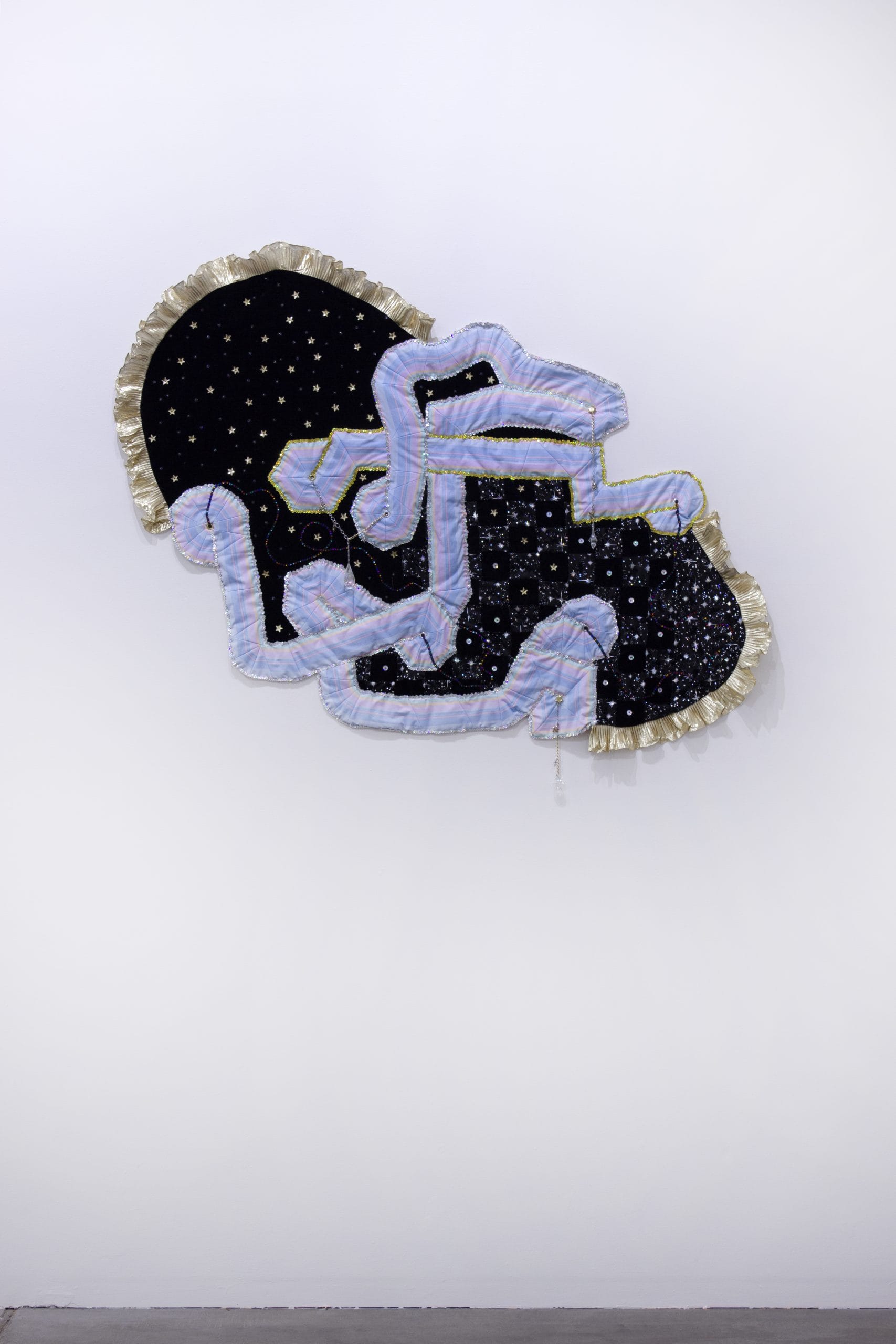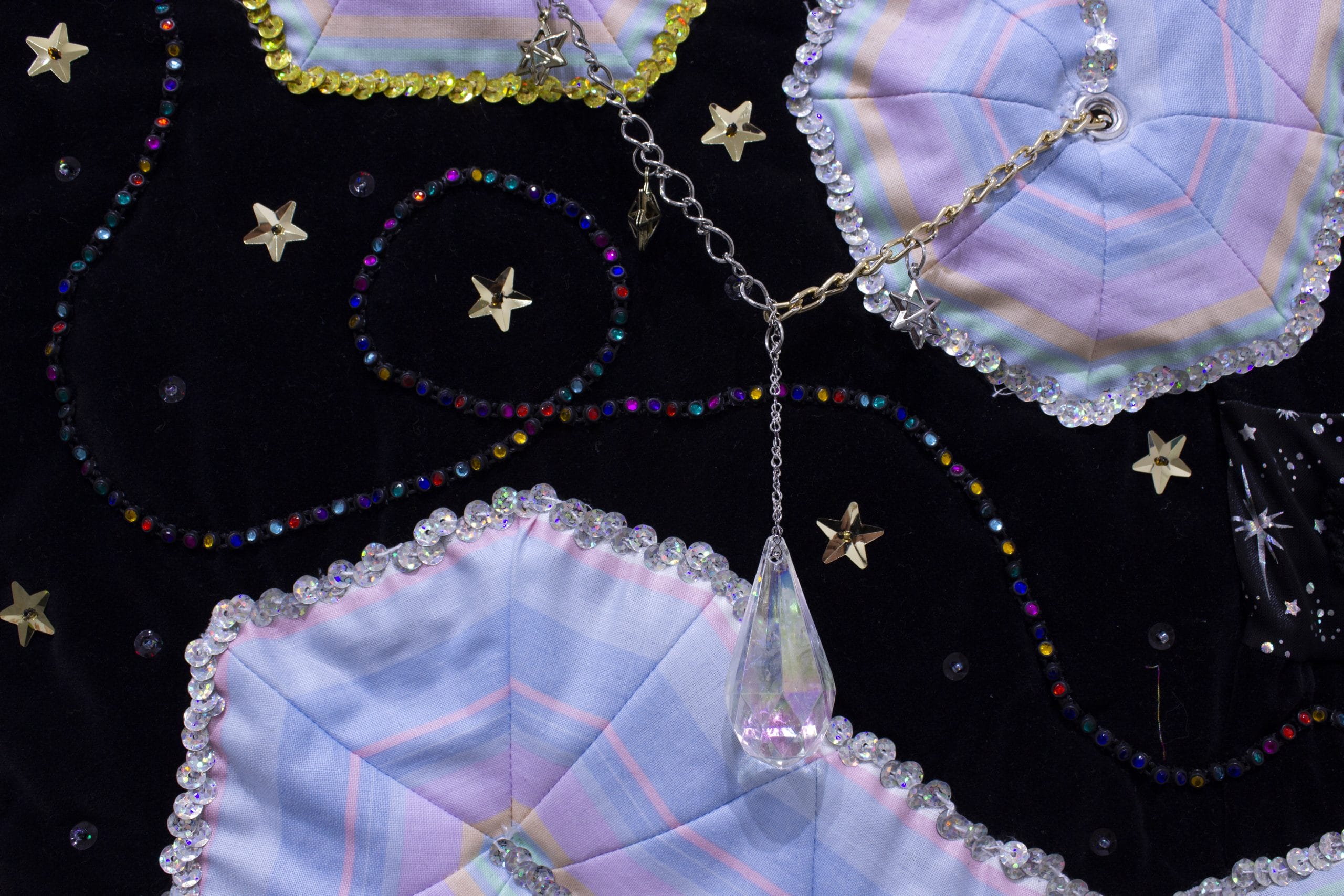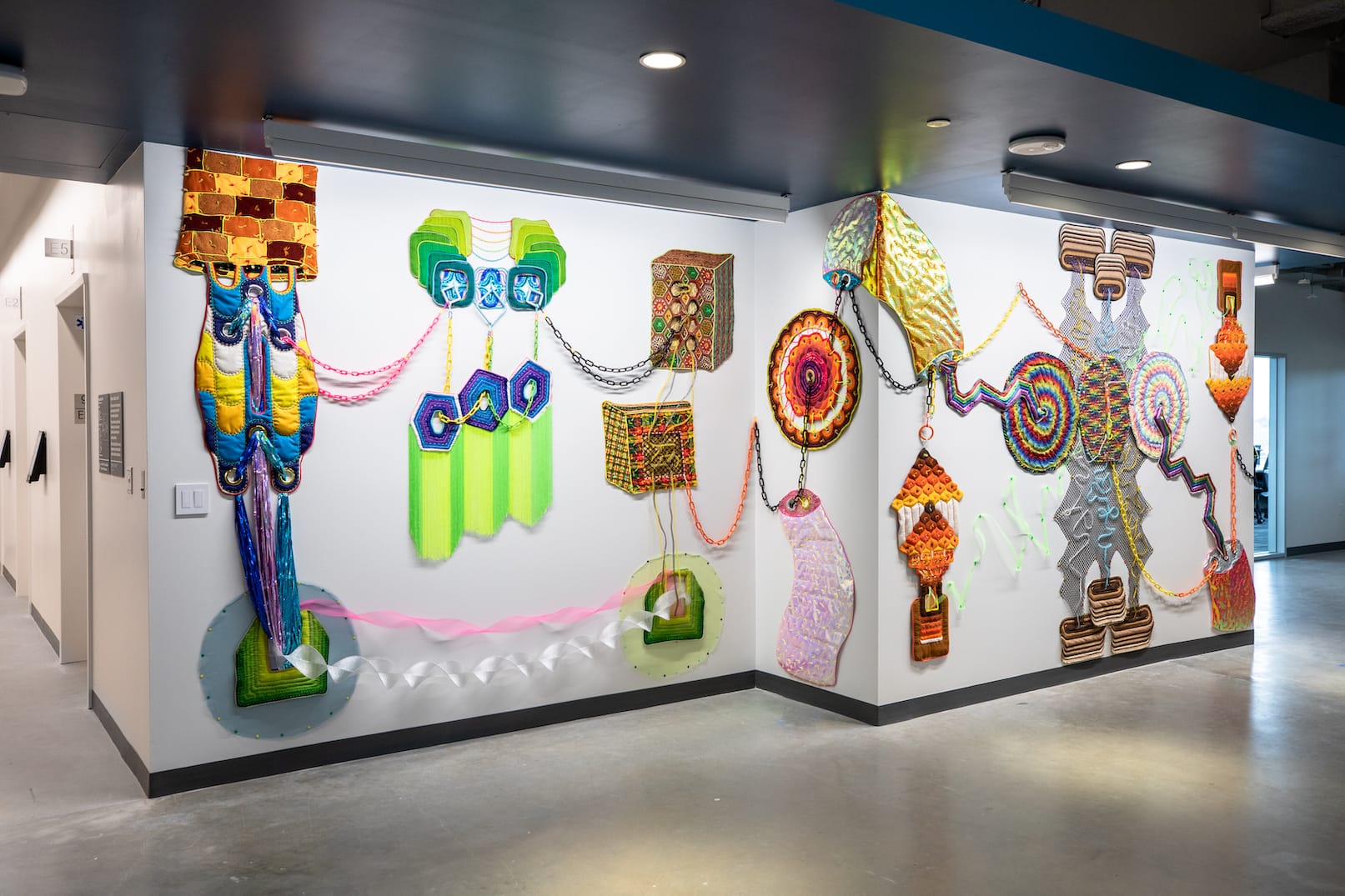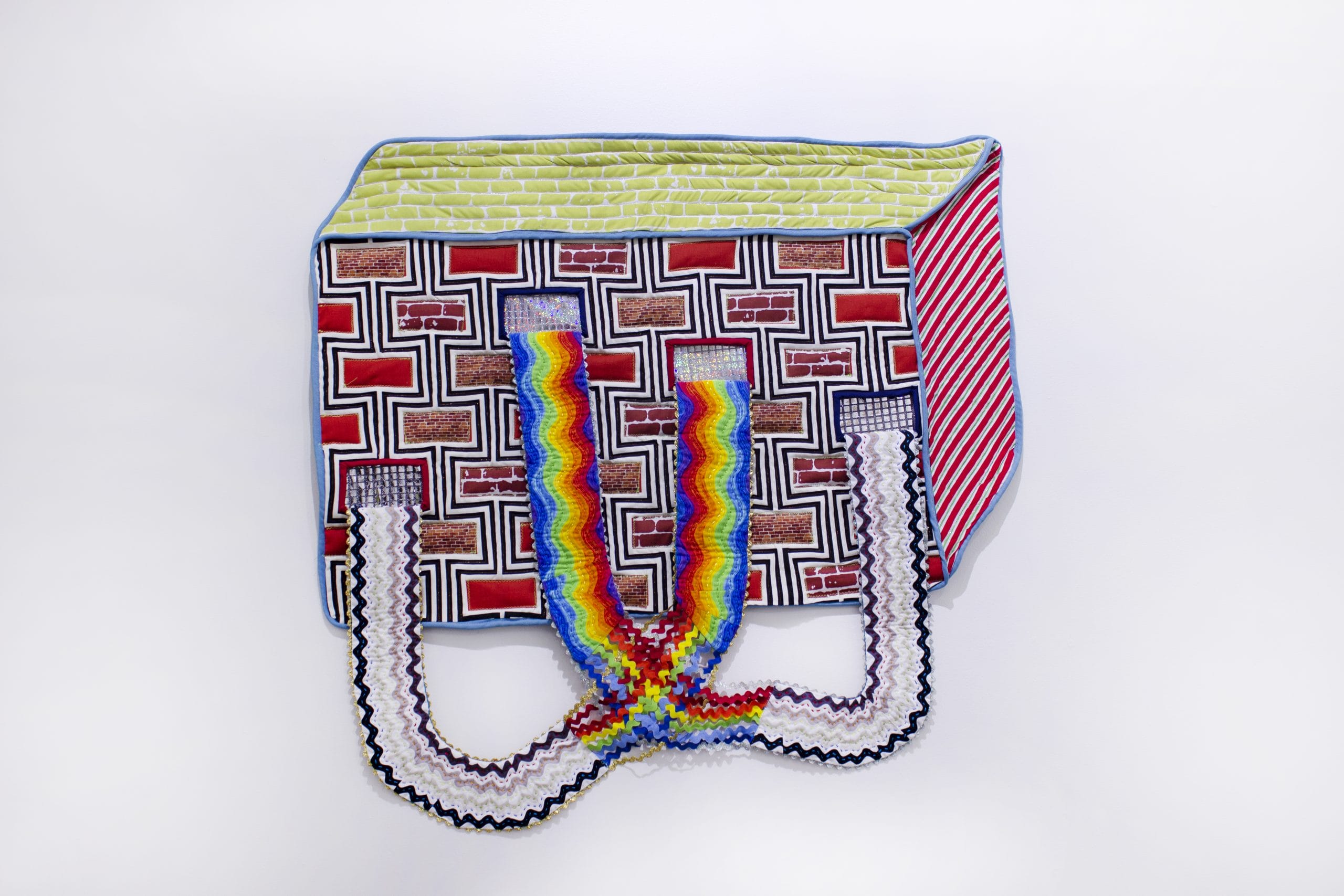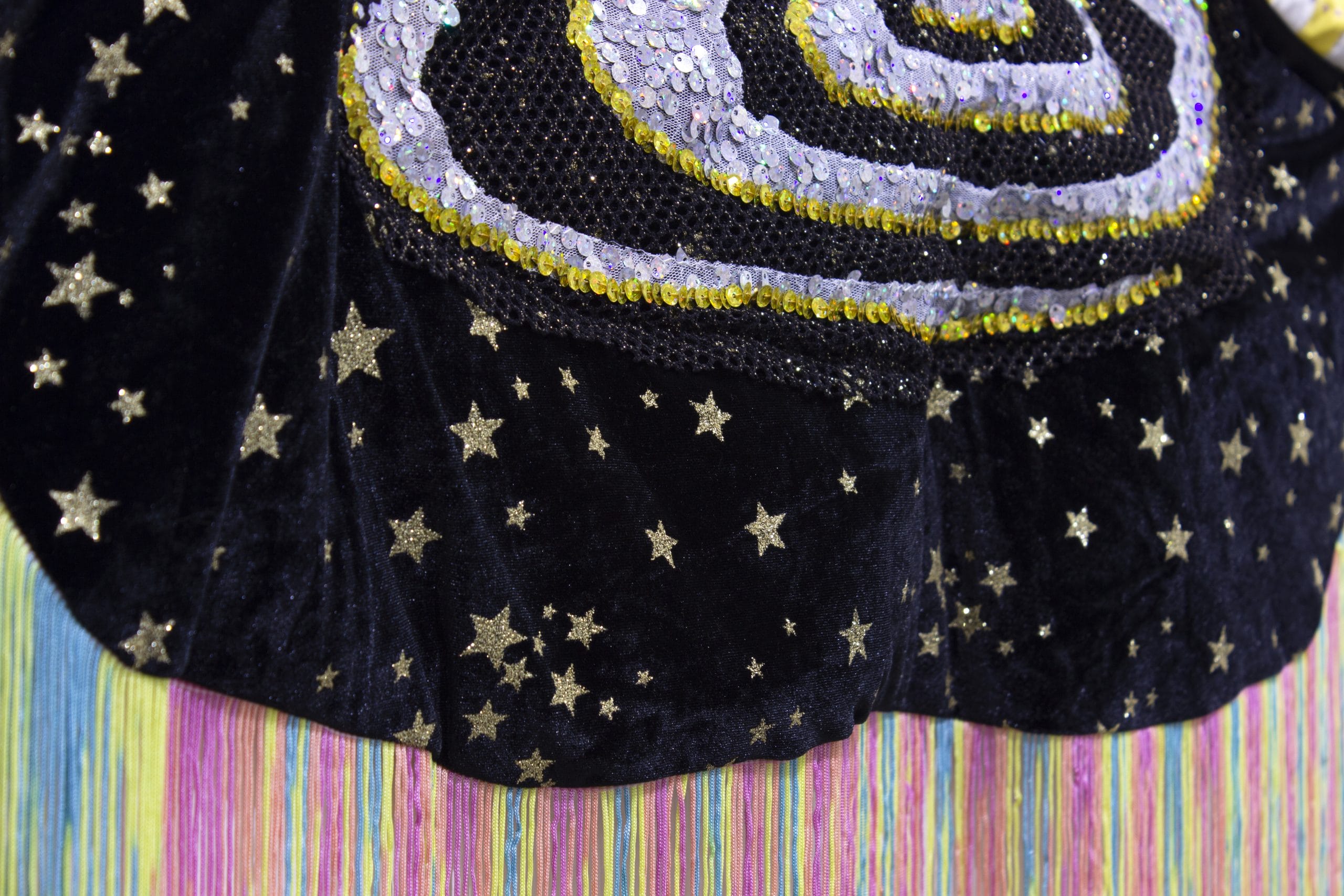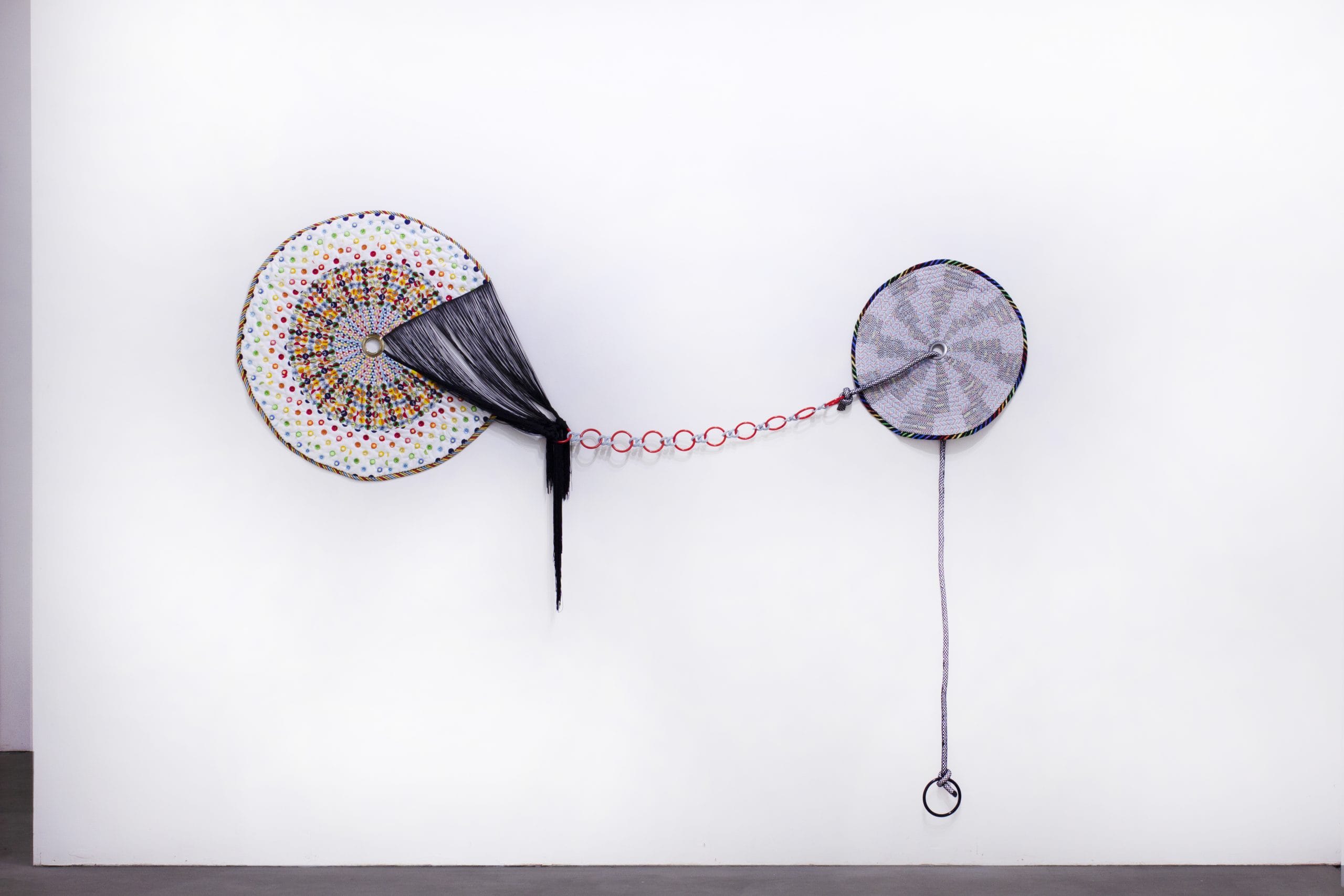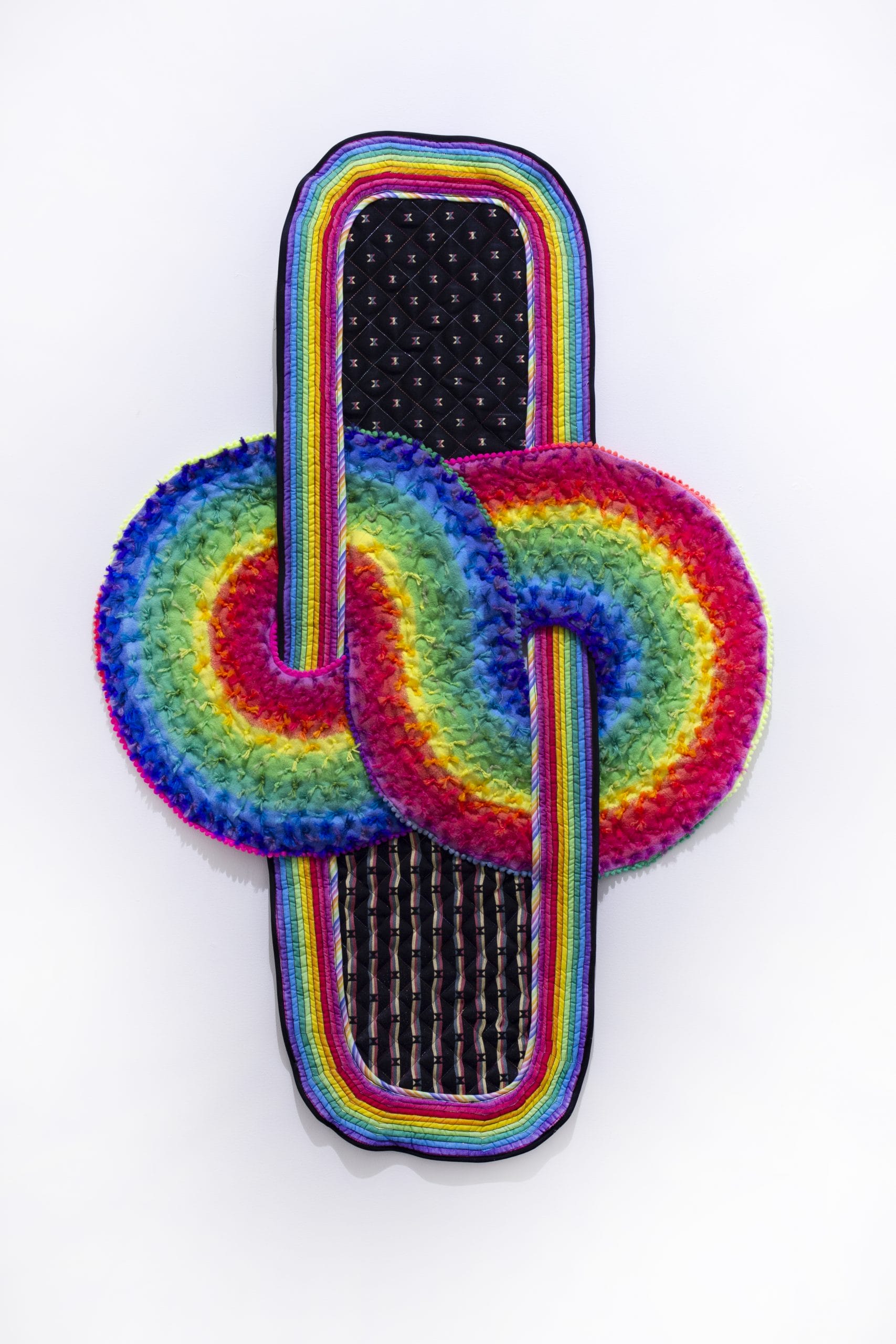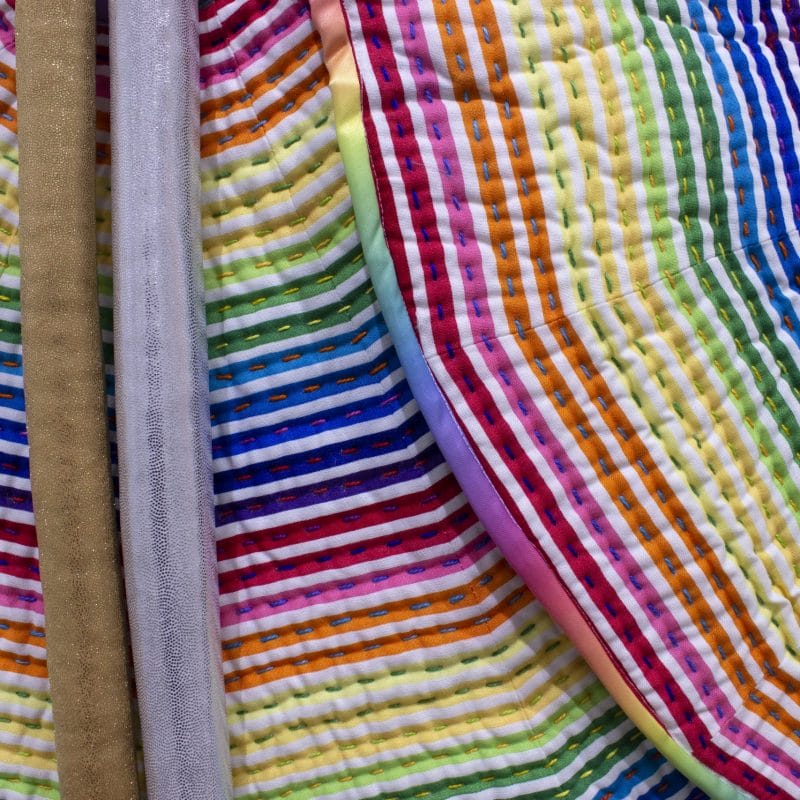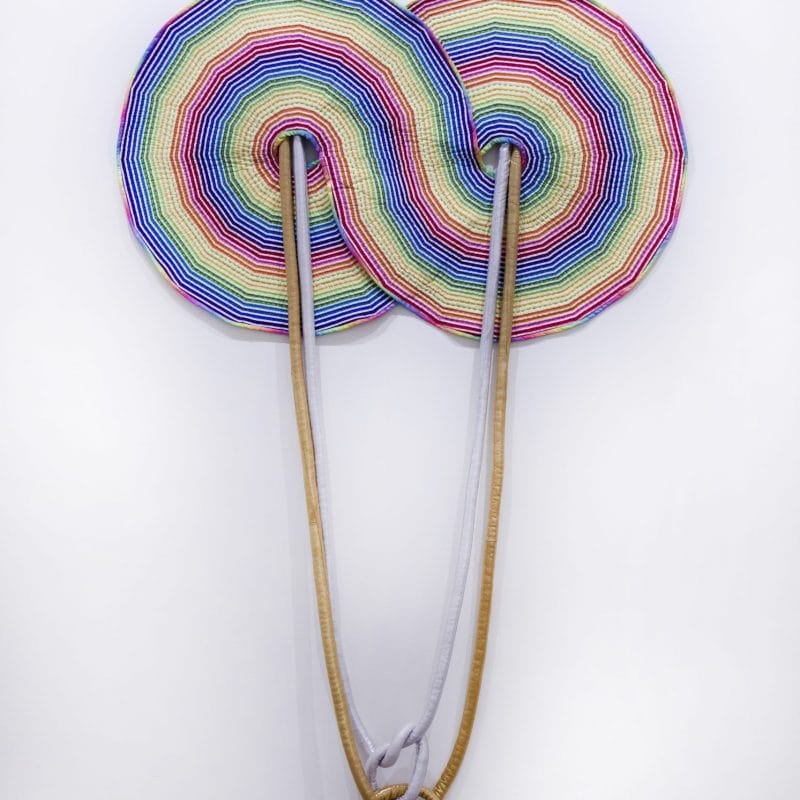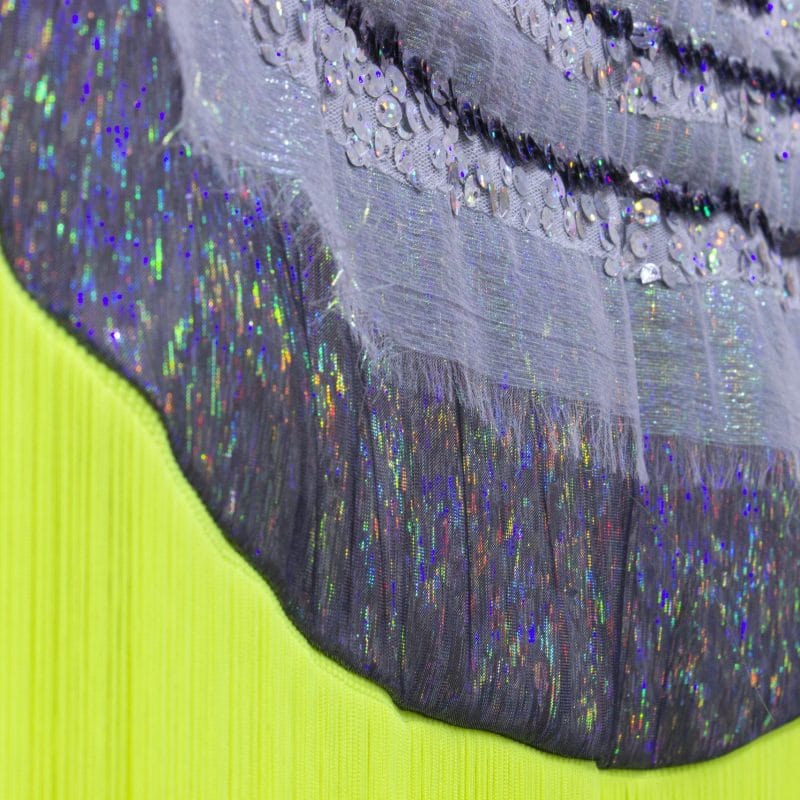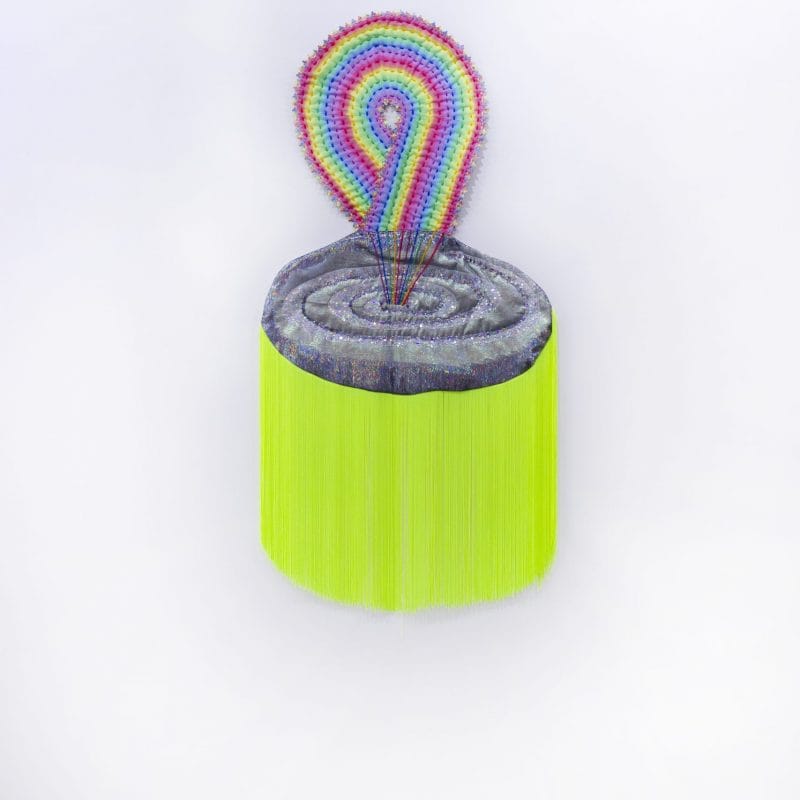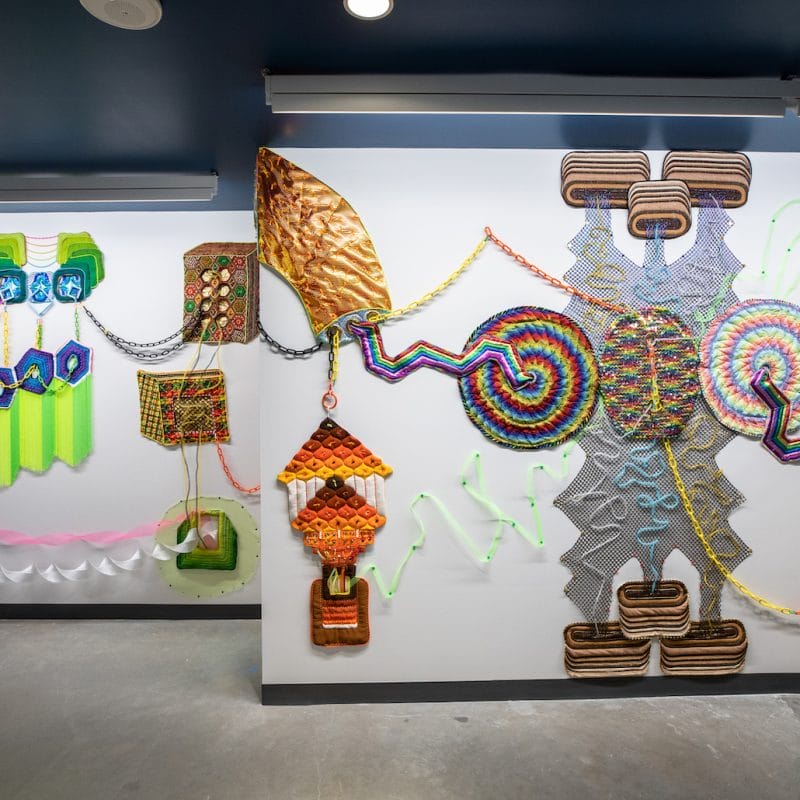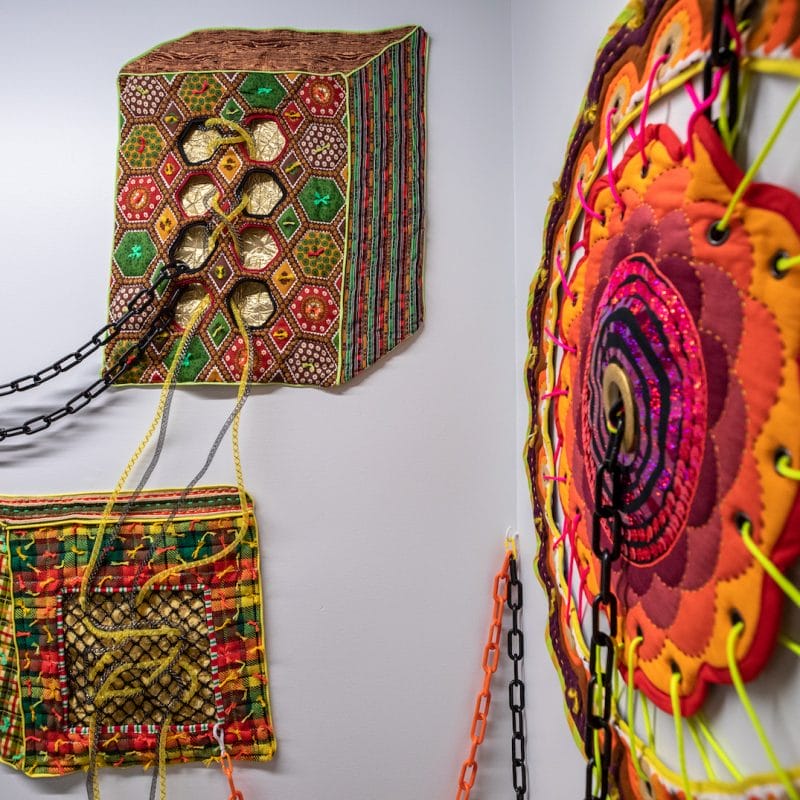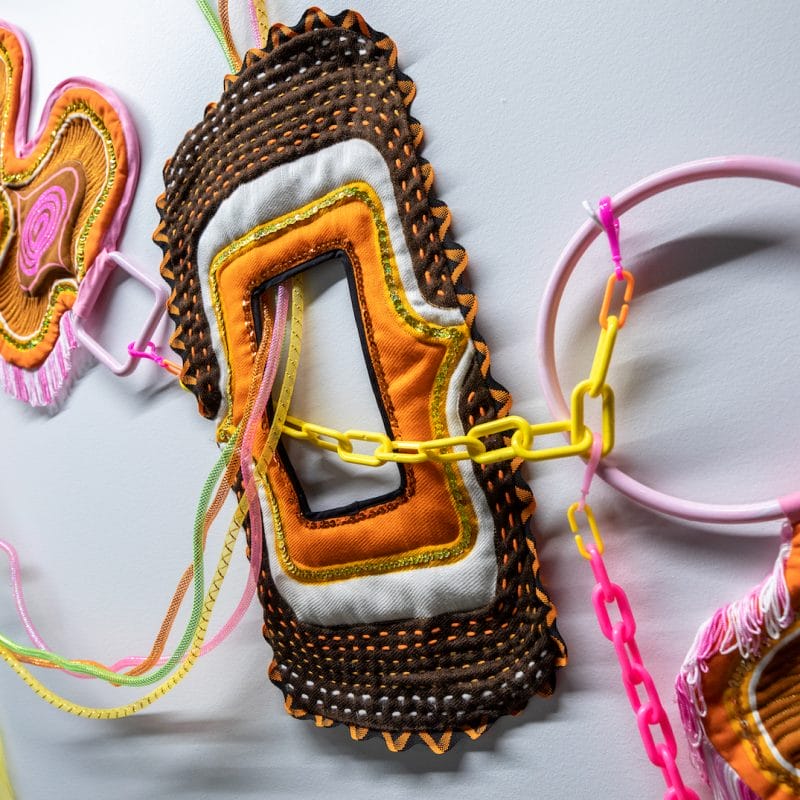Andrea Alonge
*Foto in evidenza: Reality Is Duality-detail, 2020. 50” x 56”. Fabric, trim, embroidery. Photo by John Whitten, copyright Andrea Alonge
Iridescent and multicoloured surfaces, shimmering textures and optical illusions are a few aspects of Andrea Alonge’s textile works that catch the viewer’s attention. However, beyond the threshold of this first impact, almost playful and indeed stimulating, the work shows a more spiritual content and intent. Through the use of symbols and forms, the artist explores the theme of human relationships and the connection between man, nature, society and the universe: “A thought that comforts me is the idea of our connections to everything through our chemical makeup – we are made up of the water, and the same elements as the stars and the trees, and the air that we breathe, and our universal consciousness. We are all touching. We will touch forever.”
Originally from Mesa, Arizona, Andrea Alonge received her education at the School of the Art Institute of Chicago and her Master’s of Fine Arts at Cranbrook Academy of Art, Bloomfield Hills, MI. She currently lives and works in Portland, Oregon.
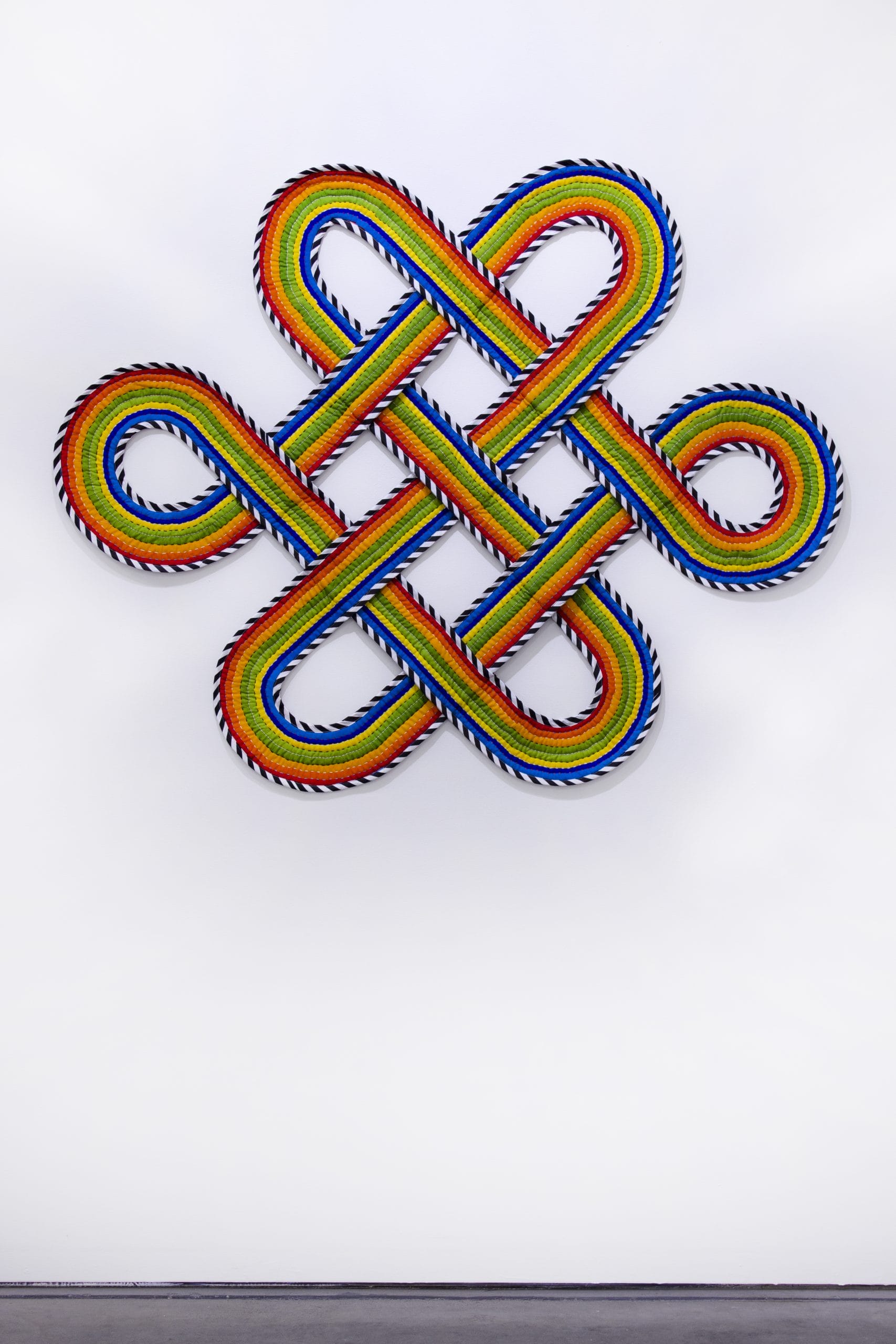
How did you approach art? What was your path, how and when did you come into contact with the textile medium?
I have been making art since I was a child, always with a focus on sculpture and three-dimensional work. I started making dollhouses and dollhouse furniture at age 8. When I started high school (secondary school), I took a ceramics class and loved it. At one point, my teacher looked at my work with me and said “you might think about going to college for this”. I had never thought of that before, but the possibility was very exciting for me and I chose to pursue an art degree with a focus in ceramics. After being in school for three years, I took a break, and during that break I realized that while I loved ceramics, it was a medium that required a lot of specialized equipment and a space dedicated to clay. I had grown up with a parent who loved textiles, and I knew how to sew and it was something we had done together. I started thinking about textiles as a medium that would be more sustainable for me in the long-term, because I owned a sewing machine and I could use it in a small apartment without needing a separate studio that could get dirty. I went back to school at The School of The Art Institute of Chicago, obtaining my BFA from this institution, and while I was there, I took many classes in the fiber and material studies department, and eventually transitioned all of my work to textile work, though I did continue to make ceramics throughout graduate school. When I graduated from SAIC, I was accepted into the Fiber department at Cranbrook Academy of Art, and the majority of the work I produced there was textile work. I am very interested in the history, critical theory, and discourse around textiles and craft as a broader category, and this medium is a perfect fit for me and the stories I tell and hope to continue telling. Textiles are tactile, associated with touch and use, and they also form the structure of our days- we wear clothes, we sleep in bed linens, we surround ourselves with textiles. Textiles also contain history- grandmother’s quilt, clothes that remind us of things that happened while wearing them, vintage textiles which remind us of the eras in which they were created. I think of textiles as objects that connect us. We are connected to the people who made our clothing, who produced the cloth.
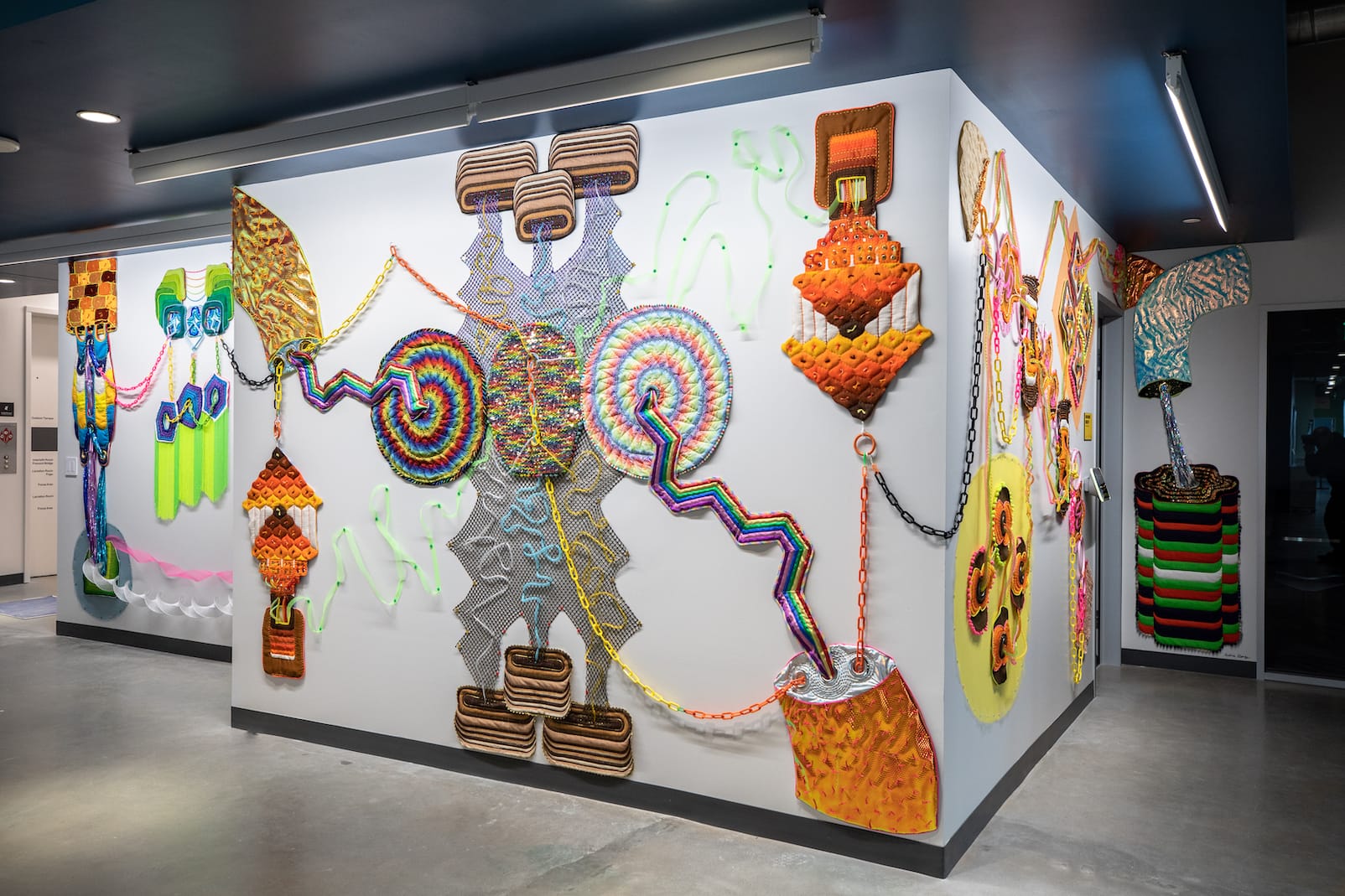
We Belong Together. Can you tell us something about this project, how it was born and what it’s about?
This project was commissioned by Meta Open Arts, which is a program founded by Meta that brings in artists to create work for Meta employee buildings in local regions. I was contacted by Meta to create a project for an employee building in their Seattle region in 2021. I began to think about textiles as a connection, and how I could use textiles as a metaphor for internet and social media connections. How do we connect through social media? The first identifier of the internet is as the World Wide Web- how could I think about what that web might look like? What does information look like as it travels from me to you? I think of the information as water- it flows from a source, through pipes and tubes, it can be clean or polluted, it can flow far and spread widely, or it can be centered in one place. I was thinking a lot about the good and bad ways we can connect, and the physical infrastructure that makes social media connection possible. In our time where we can connect with almost anyone through the web and social media, we are all connected whether we want to be or not. In all the Meta offices, there are signs for their motto, which is “stronger together”, and I thought about that when I installed the pieces and named the work. There is a Pat Benatar song with the line “whatever we deny or embrace/ for worse or for better/ we belong/ we belong we belong together” and I think that expresses perfectly the nature of social media. We are all here together, connected in this world through different avenues, and some of the ways we connect are bad and some are good, but there is no way to disconnect. We are all together, and we belong together.
How important is improvisation in your work? And what is your source of inspiration today?
Improvisation is an important part of my work that helps my ideas take shape. Since graduate school at Cranbrook, I have felt that fabric designs and manufactured textiles have played a major role in the forms my work takes. I will see a pattern that reminds me of a brick wall, for example, and the piece I make will spring from that idea of the wall. That’s what happened when I made the work “Sometimes When We Touch”, which is based loosely on the story of Pyramus and Thisbe, lovers and neighbors who were separated from one another by the wall between their parent’s houses. I think of fabric designs as a mark-making tool, drawing lines with stripes or mixing floral fabrics together to create a field of flowers. I also feel that it is important to alter the fabrics in some way with my marks; using surface embellishments such as quilting or embroidery or yarn-tying, I am able to blur the original design of the fabric and make the work my own. My current source of inspiration is universal symbols, circles, spirals, triangles, boxes, infinity signs. These are symbols that have been used since ancient times, and I am interested in how we read those symbols now and how I can connect them to the world in which we currently live. Those symbols connected us since prehistory, and were ways to leave messages for one another or to express our truths.
Is there a work or project to which you feel particularly attached or that has played a significant role in your personal and/or professional path?
I am particularly attached to a work that I made in 2020 called “The Beach Is Within Me”. During the pandemic, I, like many others, was isolated and indoors, and I wanted to make a piece that comforted me. A few years ago, I was working at a grocery store, and one of my regular customers would ask me how I was doing. I often replied “I wish I was at the beach”, which is my calming, happy place to be. She would reply “the beach is within you, Andrea”, and to me, this was a perfect reminder that the calm, still center is within me, as it is within all of us. We all have the ability to go within and find the center. When the pandemic hit, and continued to drag on and on, I began to think about this idea more and more- that we must find the place inside so we can go on and continue to live in the face of death. This piece was my response to this situation, and it is one of the most meditative works I have made, which I love.
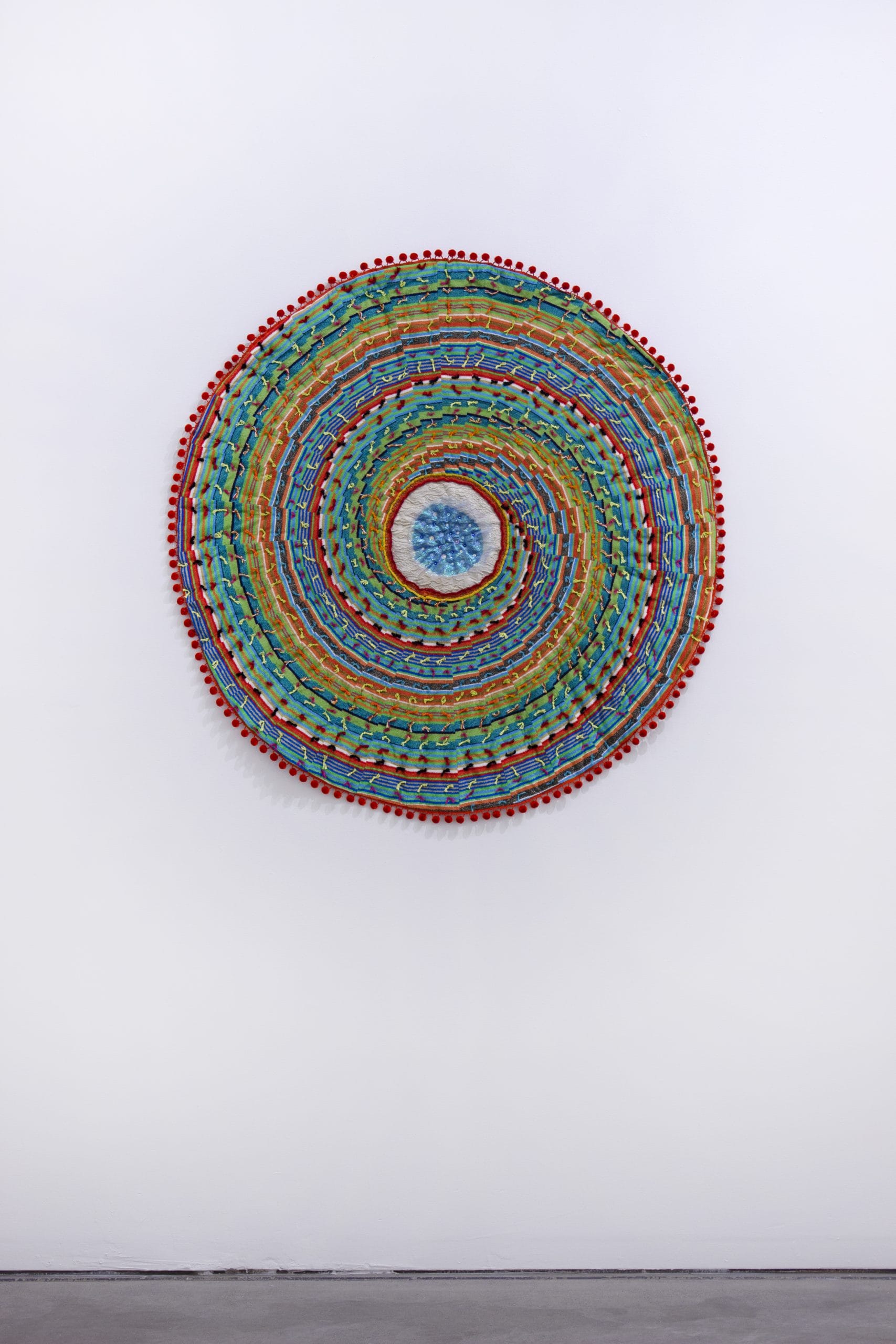
Today, social networks provide a possibility of continuous connection with a very large audience. As an artist, how do you live your relationship with the web?
I find the web to be vastly interesting, and since graduate school have always researched and thought about social networks and our connection through the web. While my work is tactile, I am interested in how it lives in a digital space and translates to a digital audience. My work is challenging to photograph- lots of sparkles, glitter, tiny stripes that become warped when shown on a screen. I love the possibility that my work changes in different formats- it will be one thing when viewed in person and another when viewed on the screen. This feels like an apt metaphor to me- our lives on social media or in the digital realm are one perspective, a heavily curated view, while our in-person lives are more complex and sometimes completely different. I am also interested in the macro/micro aspect of the work, and often build the pieces so that there are rewards for looking up close- a little bonus for those who can see them in person. I feel like the web has been very helpful for work; I can reach more people with my works than I would be able to if they only saw it in person. I’m speaking with you now, likely because you have seen the work online, and not because you have seen it in person. But I also really appreciate the ability to connect with people all over the world, and to see art that I wouldn’t see in a physical space. I also feel that textiles themselves are representative of global connections through manufacturing- so many of our textiles are made in other places in the world. Textiles and the web have intimate connections in other ways too- weaving has been described as the first computer, a series of 0s and 1s that describe information. I would also love to point out that technology and textiles are connected by us as human beings- both textiles and technology are created and maintained with human hands in conjunction with machines. The mark of the hand and the mark of the machine are both very important to everything we make as humans in this world now. We would not have textiles without the technology of the loom and spindle, we would not have the web without the technology also created by humans. So all of my work contains both the mark of the hand and the mark of the machine, and those connections are all inherent and present in the work.
How has your work changed during these last two years in which the pandemic has altered our daily lives?
My work has been about connection for many years, but now I think there is more of a focus on how important those connections are, and how to sustain them when we can’t physically touch. I find myself making work that considers how I connect to myself as well, rather than connections between myself and those outside me. The pandemic has created a need to find solace on an inner level, and to figure out the balance between loneliness and being alone. We can be alone, together. But loneliness is different. And I think that is something I’ve been thinking a lot about these past few years.
What role does color play in your practice and your work?
To me, color is nature. We see beautiful sunsets, flowers, trees, everything in nature is about color. I also think about the idea of spiritual work and connection, and how color is tied to that. You can “open your mind” through psychedelics, which change your experience of colors and patterns while also changing how you know yourself and your connection to the world and to others. Color is also related to our histories- certain colors that could only be worn by royalty, for example, or colors that were and are sacred in religious beliefs. In my personal experience, I am synesthetic, and my synesthesia is most apparent when I am reading text. Each letter has a colored “aura” behind it, such as pink for “a” or deep blue for “e”. Reading has always been a part of my life and the way that I learn information, and I believe that is in part because of the colors behind the words. I feel that color plays a major role in how we experience the world around us and in our emotional states, and this is why I use an abundance of color in my work.
What are you working on at the moment?
I am currently working on a new body of work for my solo show in July 2022 at a gallery here in Portland, Wellwell Projects. I will be debuting new work, and am taking techniques I explored through my project at Meta Open Arts to a new level. There will be more landscape influenced work in this show, and more work exploring my relationship to myself and my inner core. I am really excited to make more meditative work that the viewer can stay with for longer than a glance and see new things each moment.

